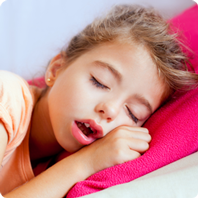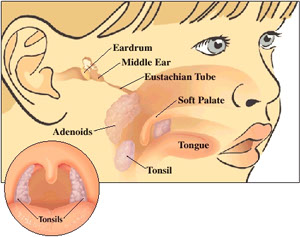Snoring and Sleep Disordered Breathing

Sleep-disordered breathing (SDB) is a general term for breathing difficulties occurring during sleep. SDB can range from frequent loud snoring to Obstructive Sleep Apnea (OSA) a condition involving repeated episodes of partial or complete blockage of the airway during sleep. When a child’s breathing is disrupted during sleep, the body perceives this as a choking phenomenon. The heart rate slows, blood pressure rises, the brain is aroused, and sleep is disrupted. Oxygen levels in the blood can also drop. Approximately 10% of children snore regularly and about 2-4% of the pediatric population has OSA. Recent studies indicate that mild SDB or snoring may cause many of the same problems as OSA in children.
Sleep disordered breathing in children should be considered if frequent loud snoring, gasping, snorting, and thrashing in bed or unexplained bedwetting is observed. Behavioral symptoms can include changes in mood, misbehavior, and poor school performance. Not every child with academic or behavioral issues will have SDB, but if a child snores loudly on a regular basis and is experiencing mood, behavior, or school performance problems, sleep disordered breathing should be considered. In most cases, the diagnosis of sleep-disordered breathing is based on history and physical examination. In other cases, such as in children suspected of having severe OSA due to craniofacial syndromes, morbid obesity, or neuromuscular disorders or for children less than 3 years of age, additional testing such as a sleep test may be recommended.
The sleep study or polysomnogram (PSG) is an objective test for sleep-disordered breathing. Wires are attached to the head and body to monitor brain waves, muscle tension, eye movement, breathing, and the level of oxygen in the blood. The test is not painful and is performed in a sleep laboratory. Sleep tests can occasionally produce inaccurate results, especially in children. Borderline or normal sleep test results may still result in a diagnosis of SDB based on parental observations and clinical evaluation.
Enlarged tonsils and adenoids are a common cause for SDB. Surgical removal of the tonsils and adenoids (T&A) is generally considered the first line treatment for pediatric sleep disordered breathing if the symptoms are significant and the tonsils and adenoids are enlarged. Of the over 500,000 pediatric T&A procedures performed in the U.S. each year, the majority are currently being done to treat sleep disordered breathing. Many children with sleep apnea show both short and long- term improvement in their sleep and behavior after T & A.

